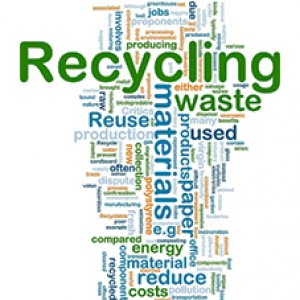
Water Treatment Chemical
Water treatment collectively referred to industrial –scale process that help in making water more acceptable for an end use which may include drinking, industry or medicine. Water treatment aid in the removal of existing water contaminants or so reduce their concentration to a level that make the water fit for its desired end use
Waste Water
Wastewater treatment is the process employed to clean effluents from industrial, commercial or residential applications so that the water may either be returned to the environment with acceptably minimal impact or reused in its initial process. Treatment is performed in 3 or more distinct stages, depending on the composition and level of the waste load bourne by the incoming wastewater.
Preliminary Treatment
The objective of the preliminary treatment process is removal of coarse solids and materials often found in raw wastewater effluents. Removal of these materials is necessary to enhance the efficacy of operation and minimize maintenance of process equipment employed in the subsequent stages of treatment. Preliminary treatment operations typically include coarse screening, grit removal and in some cases, comminution of large waste materials.
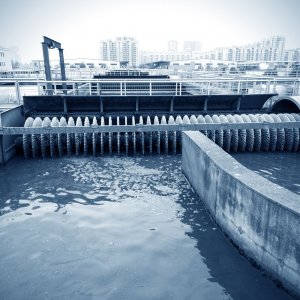
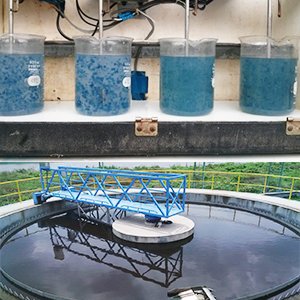
Primary Treatment
The objectives of the primary treatment process are removal of settleable organic and inorganic solids by sedimentation, and the removal floating scum by skimming. Approximately 25 to 50{bae455710082ffc188be46a81919e0436c70756a3753dc21b8bd47cd33e92f3b} of the incoming biochemical oxygen demand (BOD5), 50 to 70{bae455710082ffc188be46a81919e0436c70756a3753dc21b8bd47cd33e92f3b} of total suspended solids (SS), and 65{bae455710082ffc188be46a81919e0436c70756a3753dc21b8bd47cd33e92f3b} of the oil and grease are removed during primary treatment. Some organic nitrogen, organic phosphorus, and heavy metals associated with solids are also removed during primary sedimentation, but residual colloidal and dissolved constituents are not affected.
Secondary Treatment
The objective of secondary treatment upon receiving the effluent from the primary treatment process is to remove any residual organics and suspended solids. This stage involves the removal of biodegradable dissolved and colloidal organic matter using aerobic biological treatment processes. Aerobic biological treatment occurs in the presence of oxygen by aerobic bacteria that metabolize the organic matter in the wastewater, thereby producing more microorganisms and inorganic end-products (principally CO2, NH3, and H2O).
In high chemical oxygen loading (COD) conditons, e.g., > 3000 ppm, anaerobic digestion is more commonly utilized in secondary treatment. In this digestion process, anaerobic and facultative bacteria metabolize the organic material in sludge, thereby reducing the volume requiring ultimate disposal, stabilizing the sludge, and improving its dewatering characteristics. Digestion is carried out in covered tanks (anaerobic digesters), typically 7 to 14 m deep. Residence time in a digester may vary from a minimum of 1 day, to 60 days or more in standard-rate digesters. Gas produced during digestion may contain 60 to 65{bae455710082ffc188be46a81919e0436c70756a3753dc21b8bd47cd33e92f3b} methane and can be recovered as an energy source.
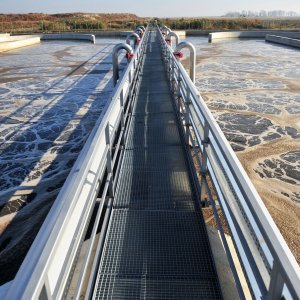
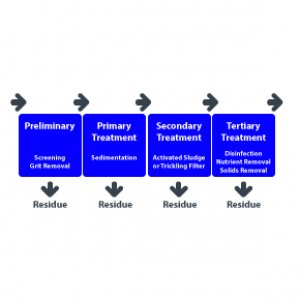
Tertiary Treatment
Tertiary treatment is an additional treatment after secondary. It can remove more than 99 percent of all the impurities from sewage, producing the highest quality effluent water. The technology employed in this process can be very expensive, and require a high level of technical know-how and well trained treatment plant operators. Tertiary treatment methods:
- Activated carbon-bed: organic waste is oxidized into CO2 and H2O by the carbon activated by heat, also removes dioxins and PCBs.
- Denitrifying bacteria: nitrates into N2
- Chemical precipitation: heavy metal ions are precipitated out by adding anions which form insolube salts with them, also removes phosphates
- Reverse osmosis and ion exchange: nitrates
- Chemical precipitation: heavy metal ions are precipitated out by adding anions which form insolube salts with them, also removes phosphates
Dewatering
The bio-solids generated by sewage treatment processes need to be dewatered in order to reduce its volume and save on disposal costs. As needed by the conditions of the process, the sludge may be wasted then further treated via mechanical dewatering units such as belt filter presses and centrifuges, additional chemicals will be added to ensure the lowest possible cake moisture content.
The Lautan Luas technical teams work closely with the customer to identify the most suitable chemicals and optimize the dosage levels to achieve the lowest possible process cost.
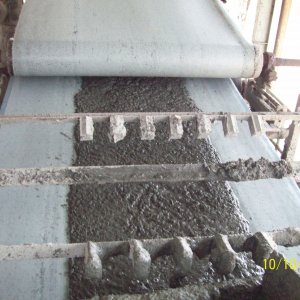
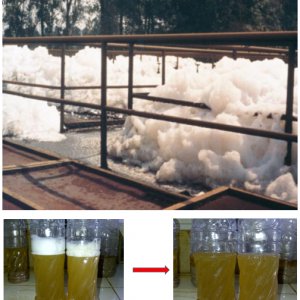
Defoamers
Mitigate foam problems.
Waste Water Treatment Management
The goal of wastewater treatment management is to achieve improvements across the whole process cycle. It involves mechanical, biological, chemical, and human elements, all of which must fall within in the correct range of values for the treatment system to be effective and reliable.
Misalignment of any one of these elements can result in a process that is inefficient and expensive to maintain. In the worst case scenario, processes may fail completely, leading to non-compliance with environmental permits or poor quality water that adversely affects your production processes.
Waste disposal costs are rising year on year. The more contaminated your effluent, the greater your effluent handling cost increase. Recognizing this condition, there are three main focus areas in which cost saving may be exploited:
- Reduce the cost/m³ of your effluent water
- Reduce the sludge volume leaving your site
- Recycle treated effluent water
The Lautan Luas team will do an extensive assessment, which is undertaken in four or more stages to optimize your processes.
At the first stage, we'll conduct a thorough evaluation of the process parameters and the external elements that affect the process. These parameters include, but are not limited to:
- The wastewater-generating process
- Chemicals used in the process
- The raw water source
- Chemical and physical water, and wastewater characteristics
- Flows and loadings of all pertinent inputs
- Peak loads and potential upset conditions
- Variability, both normal and unusual events
- Desired water or effluent quality
At the second stage, we'll review the complete treatment process and test the equipment. The evaluation includes an assessment of:
- Process type (e.g. physical/chemical, biological, mechanical, electrochemical, membrane, etc.)
- Equipment design and capacity
- Equipment condition
- Operating and maintenance procedures
- Appropriateness of the process and equipment
At the third stage we will evaluate the process controls, instrumentation, and monitoring processes to determine whether they provide the right information and/or the right control functionality. We'll make sure you're:
- Monitoring the right parameters at the right location
- Using the right test to measure parameters
- Collecting test samples properly and at the right locations
- Collecting and evaluating lab data effectively
- Logging physical and visual observations and using them to evaluate process health
- Logging data for future historical evaluations
- Using appropriate controls for the desired process adjustments
- Using the right type of instrumentation at the right location in the process
- Making the correct adjustments based on good data
At the fourth stage, we will assess your chemical usage by confirming:
- Proper chemicals are used only as needed
- Proper chemical dosage is based on use tests (e.g., jar tests, titrations)
- Use conditions are appropriate (e.g., pH, alkalinity, temperature)
- Chemicals are prepared correctly (e.g., flocculant polymers)
- Chemicals are mixed and dispersed effectively
At the final stage we will assess operator knowledge to confirm that your staff understands the process required for optimal system operation. The operator assessment covers:
- Chemistry basics
- Treatment plant process fundamentals
- Treatment process parameters and control methods
- Target ranges for control parameters and how to adjust them
- The effect of variability on treatment processes
- Lab tests and physical/visual monitoring
- On-line controls
- Responding to upset conditions
